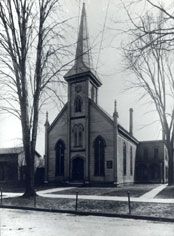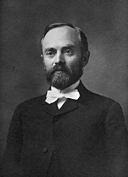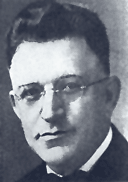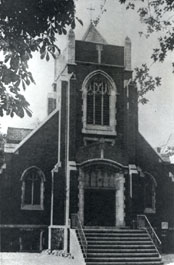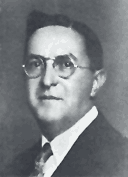 |
 |

|

|

|

|

|

|
|
Protestants began with the Reformation in 1517, when Martin Luther posted his theses on the cathedral door at Wittenburg, Germany. At the time several major denominational branches developed in the Protestant church. Among the Swiss and German speaking people, the two major branches were the German Lutheran and the Swiss-German Reformed. These branches lasted for about three centuries and parts of each joined together as the Evangelical United Churches of Germany in 1817. Remaining parts of the German Lutheran spawned the various Lutheran denominations that we know today, while other parts of the Swiss-German Reformed developed into the German Reformed Church. The Evangelical United Churches of Germany eventually led to an Evangelical Synod of North America, while the German Reformed Church eventually produced the Reformed Church of the United States. These two American branches joined and became Evangelical and Reformed Church in 1934. Twenty-three years later in 1957, the E & R merged with the General Council of the Congregational Christian Churches to become the present day United Church of Christ, or U.C.C.
The first officers were: Henry Fauhl, President; Paul Krause, Secretary; Gottlob Moebius, Treasurer; Frederick Schaible and John Hafner, Trustees. Times were not easy in 1871. The economy of the land had suffered from the issuing of unsecured money, from the abnormal demands of war production, and the wanton destruction of resources. The usual war aftermath of political corruptions and financial speculation, together with business depression were upon the land. What unfavorable days these were to launch a new church. Yet this was when St. Paul Church began, and by people hardly off the boats from Europe, and anything but financially secure themselves. How easily they could have said, "This is not the time to begin a church. Let us wait." However, our forerunners in this congregation did not wait. They possessed that pioneering, adventurous spirit which put both church and school on an equal with family and home. These were their great loves. Other things could wait, but never these. So, as they proceeded to establish new homes in this new land, and build their houses, they also erected churches and made provisions for schools. These were the essentials of life. Usually a newly organized church must wrestle with a building problem, but in this instance the newly organized congregation was fortunate enough to purchase the former church building of St. Andrew's Episcopal Church on the south side of Third Street, east of Middle Avenue. On the fifth day of November, 1871, the church was rededicated. Many visitors from Cleveland attended. Rev. Stempel of Cleveland was the principal speaker and the choir of his church sang for the occasion. Early pastors were Free Protestants who were not associated with a larger domination. Several of these men served St. Paul during its first two years. Finally in 1873, St. Paul became a member of the German Evangelical Synod of North America. The first pastor to serve the congregation from the Synod was Rev. Paul Scheliha (1873-75). He was followed by Rev. J. C. Seybold (1875-77) and Rev. G. Schoettle (1877-78). Up to this time St. Paul's was a charge with the church at Liverpool (now Valley City). Rev. Christian Spathelf was the first man to serve St. Paul Church only. He remained until July, 1880. He was followed by Rev. C. W. Locher, Sr., who ministered to the church from July, 1880, until his death, February 6, 1888. His son, Rev. C. W. Locher, Jr., was chosen to succeed him. He served until January, 1892. During the pastorate of these two men the congregation grew considerably.
Then the congregation called Rev. Nathaniel Lehmann, who took charge in October, 1896, and remained as pastor until December, 1913. These seventeen years of faithful and conscientious work were crowned with success and many blessings. In 1899, a commodious parsonage was built on the north side of Third Street, west of West Ave. The report of Rev. Lehmann given at the annual congregational meeting at that time records that the sum of $3,053.82 was given for the erection of the parsonage and for the lot which it occupies. To achieve this purchase, the congregation had to borrow $1200. The old parsonage, which originally had been joined to the church building, was moved to the rear of the church property and was occupied by the caretaker's family. Rev. Lehmann's picture is the oldest photograph of a minister in the St. Paul UCC collection (he is also the great-grandfather of our church historian, Bill Bird). Originally the membership was made up of German-speaking people and all its services were conducted in the German language for the first three to four decades. Rather reluctantly the congregation decided to hold some services in the English language. It soon became evident, however, that this move was a wise one, for German immigration had practically ceased and a new generation was active in the church, which did not understand the language of the fathers. It was during the pastorate of Rev. Lehmann that the need for a larger and more modern church building was realized and the beginning was made for a building fund.
The first mention of the need for a new church is found in the minutes of the church meeting of April 8, 1910. There we find recorded: "After lengthy discussion it was decided that two subscription lists be circulated, one for building a new church and the other for repairing the old." The committee to solicit these subscriptions consisted of Rev. Nathaniel Lehmann, Charles Pallas, and K. W. Klein. This committee reported in the following quarterly meeting and was then encouraged to continue its work. In the next meeting of October 10, 1910, this committee reported that it had received subscriptions amounting to about $3,000. After discussion it was decided that an estimate of the cost of a new building and also of the cost of reconstructing the old should be submitted in the next meeting. The architect whom the committee consulted expressed the opinion that it would be inadvisable to reconstruct the old building.
After this, nothing is reported until the quarterly meeting held October 15, 1915, when a committee of five members were appointed to submit plans and estimates in the next meeting. This committee reported on January 9, 1916, that architect Hinsdale of Cleveland had been consulted and that the plan which he submitted seemed acceptable to the committee. Upon his recommendation it was decided that arrangements should be made for all who were interested to go to Cleveland and inspect a church building there, which had been constructed according to the proposed plans. Then it was decided that the task of soliciting subscriptions for the new church should be given to the Men's Club. Two weeks later those who had gone to Cleveland reported favorably. Thereupon the motion was made and carried to build a new church. After this the records of the church are almost silent about the building. It seems while the building was in progress, a great deal was done, but little was said. We do know that in September of 1916, the church building was sold and moved to another property on Middle Avenue near 16th Street. On September 17, 1916, the cornerstone was laid for a new church which was built on the same site as the original building, at 250 Third Street.
The new building was dedicated on Sunday, September 9, 1917, with former pastor Rev. N. Lehmann being one of the principal speakers. Afterwards, all members and guests were served dinner in the church basement. The offering that day amounted to $800. The entire cost of the church was $31,755.00. The organ in this building was dedicated in February, 1918. After the resignation of Rev. Krause, Rev. J. K. Bischoff of Oberlin served as a supply pastor until the church called Rev. Paul Bourquin of Indianapolis, Indiana as its pastor. During Rev. Bourquin's pastorate, the congregation celebrated its Fiftieth Anniversary on October 16-18, 1921. |
